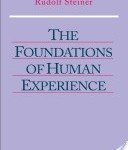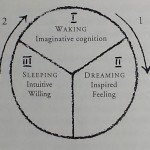Why do I love reading Steiner’s lectures to teachers?
Because Rudolf Steiner had keen insights into human nature. And when applied to teaching children, I’ve seen his ideas hit home time and time again. Steiner’s insights ring true from both a pedagogical and developmental perspective.
I also love the idea of a group of hopeful adults gathering in a cafe in 1919 to listen to and discuss ideas about a new school, a new way of teaching and learning. For two weeks. And then they set out to give it all a try.
This lecture took place on Day Six in the morning. And it’s a challenging one. When I come up against these challenging, philosophical lectures, I read some, let it sit, read some more and then trust that what’s relevant to me and my life right now will bubble to the surface.
In this lecture, Steiner reminds us that: “Whenever you want to suitably consider the human being from any particular standpoint, you must always return to the three parts of the human soul – that is, to cognition that occurs in thinking, to feeling, and to willing.” And that “Feeling stands midway between willing and thinking.”
Steiner describes us as being awake and partially asleep, even during the daytime. Cognitive thought is the result of being awake. But we also always have within us “the inner essence of willing” which comes from a part of us that is asleep; and “feeling is midway between waking and sleeping,” a kind of dreaminess. Feeling is where our consciousness is not fully awake but is partly in the dream state, and children will vary as to how wakeful or sleepy they are.
How does this apply to children and pedagogy? Steiner says that we can effectively reach “dreamy children” through strong feelings, “that these strong feelings will awaken the light of cognition in these children.” And broody children, who may appear numb to the feeling life, can be very strong willed. But we want to awaken their will fully. Steiner suggests, “for instance, when they are speaking, you also have them walk.”
Alison: I guess where I am as a teacher/parent with all of this abstract theory is that we need to observe our children and how “awake” they are – this will relate to both their ages and their temperaments. Young children are dreamy but as they grow and mature it is important to bring them to wakefulness with pictures (images that correspond to conscious thoughts). A mind full of beautifully transmitted pictures (imbued with feeling and images of the highest human capacities) is awake and capable of action informed by reason.
Here is an image of “Waking, Dreaming and Sleeping” from Day Six in The Foundations of Human Experience.
This is a process – but if you have a “sleepy” student or one that is too “awake” for his or her age, Waldorf pedagogy has some very wonderful solutions – recitation, movement, music and drama, painting and drawing!! Once again, Steiner gives us tools for observing our children and working with them individually.
Have you grappled with this lecture on Day Six? What did you take away?
The Steiner Cafe is a place to explore and reflect on the lectures that Rudolf Steiner gave at the Teacher’s Seminar in 1919, the very first Waldorf teacher training. Each month here, we ponder one day of the seminar.
To read reflections on previous lectures, check out The Steiner Cafe page.
These lectures are published in three books; the morning lectures in The Foundations of Human Experience; later morning lectures in Practical Advice to Teachers; and afternoon lectures in Discussions with Teachers. We invite you to pick up the books and read along.
If you prefer, you can read online at www.rsarchive.org, or listen at www.rudolfsteineraudio.com. Or, just meet us here each Thursday or Friday at The Steiner Cafe for some lively discussion. Lot’s of options! Hope you’ll join us.





I have not read this lecture, but I like the advice having the strong-willed child walk while he talks. Interesting . . . as I *might* just have one of those strong-willed children Steiner speaks of.
Love you guys.
S
You just *might*! And yes, it is helpful to think in terms of having strong-willed children engage in activities that get them even more focused in their will! Counter intuitive in a way. It’s the same principle as meeting the temperament and going “in the direction of” rather than trying to change it into something else (that we desire). I know from whence I speak, because I just *might* have one (or two…) of those children!
Thank you for your thoughts Jean and Alison. I am not reading the lectures along with you right now, but I sure appreciate hearing your thoughts.
Thank you! It was interesting to see Steiner’s practical advice coming back to movement and hands-on learning once again. We are all offering our children rich and lasting learning experiences through the Waldorf method! Good to affirm that now and again…
I agree!